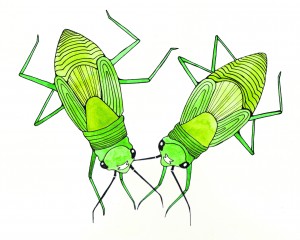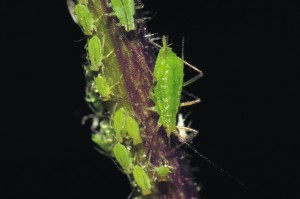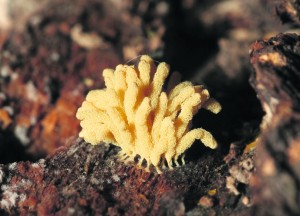WEDNESDAY, 18 JANUARY 2012
For greenfly, sex is an exceedingly rare event. When adults first emerge in the spring, the entire population is composed of females. Soon, without any fertilisation, an embryo develops inside each of these females. Then a granddaughter grows inside the embryonic daughter. Throughout the summer, greenfly reproduce in this Russian doll-like manner, with each generation only surviving for about a month. The coming of autumn signals the end of the breeding season: for the first and only time, males are produced alongside females. These offspring subsequently mate, forming ubiquitously female eggs, which lie dormant for the winter, ready to give rise to the mothers of the following spring.Greenfly employ a rather bizarre strategy, but most animals reproduce sexually. In purely probabilistic terms, however, we would not expect it to be so. In Ridley’s hypothetical scenario, four individuals are trapped in a cave. Two are sexual men; one is a normal female, and the last, a mutant female who can reproduce asexually, called a parthenogen. Given that humans usually reproduce monogamously one of the males fails to find a mate and, consequently, his genes fail to perpetuate. In the first round of reproduction, each female produces two offspring: two female parthenogens for the asexual female and a sexual boy and girl for the sexual female. Subsequently, each female from the second generation reproduces, producing two offspring in the same patterns as before. If the first (founding) generation dies, the cave will be populated by six parthenogens, accompanied by two sexual females and two sexual males. In other words, the proportion of parthenogens has increased from twenty five percent, to sixty percent, in only three generations. The rapid rise of parthenogens in Ridley’s cave illustrates how asexual reproduction is far more efficient and reliable than sexual reproduction; moreover, asexual reproduction guarantees an organism’s genes’ delivery into the next generation. Why, then, has sex, in many cases, proved to be evolutionarily advantageous?
The existence of parasites provides the most compelling hypothesis. Ever since life bloomed, organisms have struggled against pathogens. For example, viruses, such as measles, invade cells, capture their machinery, replicate, and kill the cell directly, or target it for destruction by the host’s immune system. Infection is energetically expensive and may result in the organism’s death or sterility.
A computer model, constructed by evolutionary biologist Bill Hamilton, illustrates the advantages of sex. Like in Ridley’s cave, asexual ‘species’ held the upper hand, that is, until parasites were introduced. In the presence of parasites, sex won the game outright. Under pathogenic pressure, the simulated sexual ‘species’ evolved new ways to shut out and annihilate the parasites, far more readily than the asexual organisms. Pathogens were no longer able to sweep from parents to offspring, to siblings and to cousins, without modification. The resistance of sexual species to pathogen colonisation is the most likely driving force for their otherwise surprising evolution.
Both in reality, and in Hamilton’s simulation, the success of sex is dependent on genetic mixing. When sex cells are produced, genes hop between the organism’s own chromosomes, and fertilisation produces offspring which are syntheses of both parents’ genetic material. This random trading of DNA clothes each individual’s cells in a unique combination of proteins, which act as cellular locks. Like assigning different codes to your house alarm, computer password and credit card pin, such a system minimises the risk that an intruder will wipe out all of your possessions in one fell swoop.
For genes housed in large species, sex is a crucial security procedure; but, many small species do well without it. Unlike us, truly asexual species, such as the Bdelloid Rotifer, a type of mite, reproduce rapidly and often endure torturous phases in their lifecycle to escape extinction. When an organism copies its DNA to pass on to its offspring, mistakes are inevitable. Reproducing rapidly means that these mutations accumulate relatively quickly with respect to time. This way the locks are changed sufficiently frequently to keep the parasites out. Additionally, in periods of environmental stress, Bdelloid Rotifers dry up and float on the wind, before rehydrating in a new location with more favourable conditions. The most convincing explanation for such behaviour is that, like sex, this inhospitable ritual has evolved as a mechanism to escape disease.
Although many organisms have adopted sexual reproduction in order to minimise the impact of parasites, not all species have distinct sexes. Bacteria can reproduce sexually, via a mechanism termed conjunction. DNA is rapidly transferred through a narrow pipe, which forms between the two interacting cells. Although one bacterium seems to prepare itself for receiving, and the other adapts for giving, all cells can perform both roles, so no sexes as such exist.
By contrast, all organisms which reproduce via the fusion of gametes seem to require distinct sexes. The reason for this is probably the result of a lasting pre-historic interaction. Millions of years ago, bacteria entered the cells of larger organisms and forged a symbiotic relationship. The new, cellular bacteria evolved into organelles—mitochondria and chloroplasts—providing their hosts with energy and benefitting, in return, from nutrients and a stable environment. Organelles, like individual cells, contain their own DNA. If an organelle detects the presence of other organelles, which are genetically different to themselves, a conflict may ensue—much as your body attacks a transplanted organ. This can have fatal consequences for the host cell. To circumvent this problem males contribute the small, mobile, organelle-free gametes; whilst females are the source of large, relatively static sex cells, which supply organelles to the embryo. In this manner, the male sacrifices his organelles’ dynasty in order to better ensure the perpetuation of his own nuclear genes into future generations.
Distinct sex cells also exist in the plant kingdom; however, individuals tend to be hermaphrodites, containing both male and female parts. The immobility of plants, and their dependency on vectors to transport pollen, makes finding mates a risky business. Being able to mate with any species member is therefore a significant advantage. Similarly for the slime mould having a large pool of potential mates seems to be important. In this species no fewer than thirteen sexes exist. Fertilisation occurs within a complex hierarchy which enables individuals to mate with twelve thirteenths of the population.
Most animals, on the other hand, are divided into two discrete genders. Animals benefit from much greater mobility, than either plants or slime mould, making finding a partner much less of an issue. Furthermore, the system of reproduction in slime mould is so complex that it is prone to errors, which result in the death of offspring.
So, it seems that the greenfly have it right. The summer period of rapid asexual reproduction enables an efficient and reliable proliferation of genes: one founding mother can produce thousands of descendants in a single summer. Meanwhile, the sexual phase of reproduction prior to the winter latency, reshuffles the season’s genes, kicking out the majority of pathogens which have evolved over the summer. In this way, mass reproduction is achieved without compromising the breeding success of the following year.
Although such a strategy is extremely effective for greenfly with their rapid reproductive cycle, larger organisms have longer reproductive intervals. In the face of rapidly evolving parasites, these slow-maturing organisms require a diversity boost to keep disease at bay. This is the need for sex.
Anna Wlison is a 2nd year undergraduate in the Department of Veterinary Medicine



